-
Product Name
HADHA antibody
- Documents
-
Description
HADHA Rabbit Polyclonal antibody. Positive WB detected in mouse kidney tissue, HEK-293 cells, HeLa cells, HepG2 cells, Jurkat cells, MCF7 cells, MDA-MB-453s cells, mouse heart tissue, mouse liver tissue, Raji cells, rat kidney tissue. Positive IP detected in HEK-293 cells. Positive IF detected in HepG2 cells. Positive IHC detected in human colon cancer tissue, human lung tissue, human ovary tissue, human placenta tissue, human spleen tissue, human testis tissue. Positive FC detected in HepG2 cells. Observed molecular weight by Western-blot: 70-79 kDa
-
Tested applications
ELISA, WB, IHC, IF, IP, FC
-
Species reactivity
Human, Mouse; other species not tested.
-
Alternative names
78 kDa gastrin binding protein antibody; ECHA antibody; HADH antibody; HADHA antibody; LCHAD antibody; MTPA antibody; TP ALPHA antibody
- Immunogen
-
Isotype
Rabbit IgG
-
Preparation
This antibody was obtained by immunization of HADHA recombinant protein (Accession Number: NM_000182). Purification method: Antigen affinity purified.
-
Clonality
Polyclonal
-
Formulation
PBS with 0.1% sodium azide and 50% glycerol pH 7.3.
-
Storage instructions
Store at -20℃. DO NOT ALIQUOT
-
Applications
Recommended Dilution:
WB: 1:500-1:5000
IP: 1:200-1:1000
IHC: 1:20-1:200
IF: 1:10-1:100
-
Validations
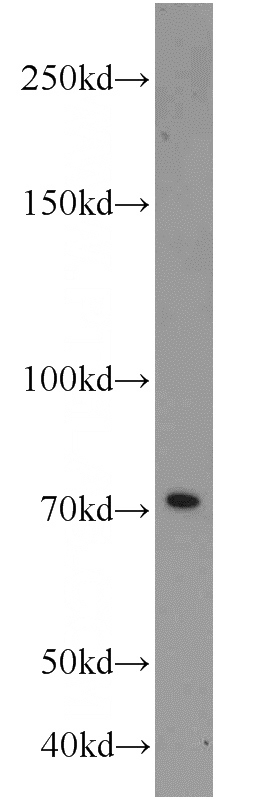
mouse kidney tissue were subjected to SDS PAGE followed by western blot with Catalog No:111333(HADHA antibody) at dilution of 1:1000
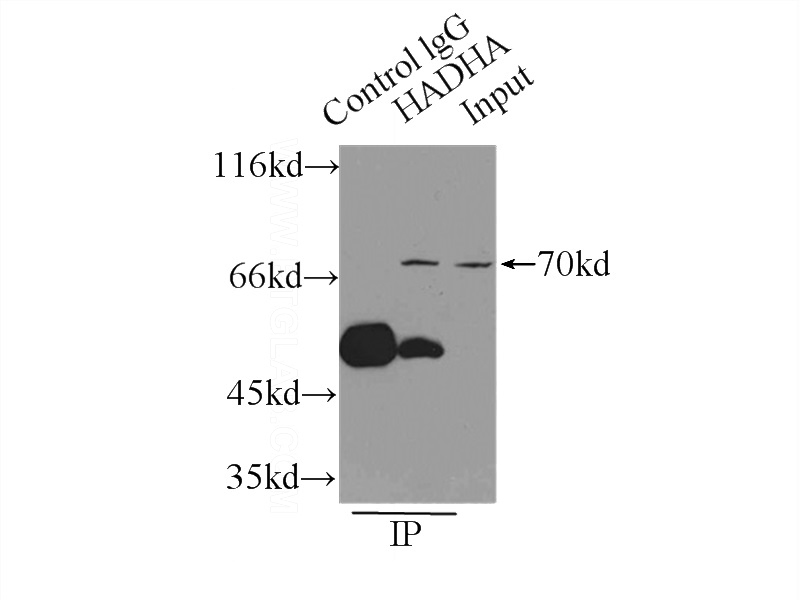
IP Result of anti-HADHA (IP:Catalog No:111333, 4ug; Detection:Catalog No:111333 1:200) with HEK-293 cells lysate 2500ug.
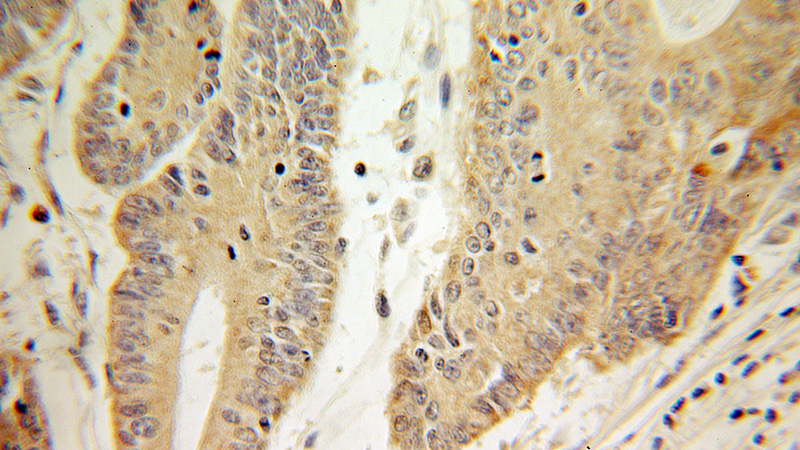
Immunohistochemical of paraffin-embedded human colon cancer using Catalog No:111333(HADHA antibody) at dilution of 1:100 (under 40x lens)
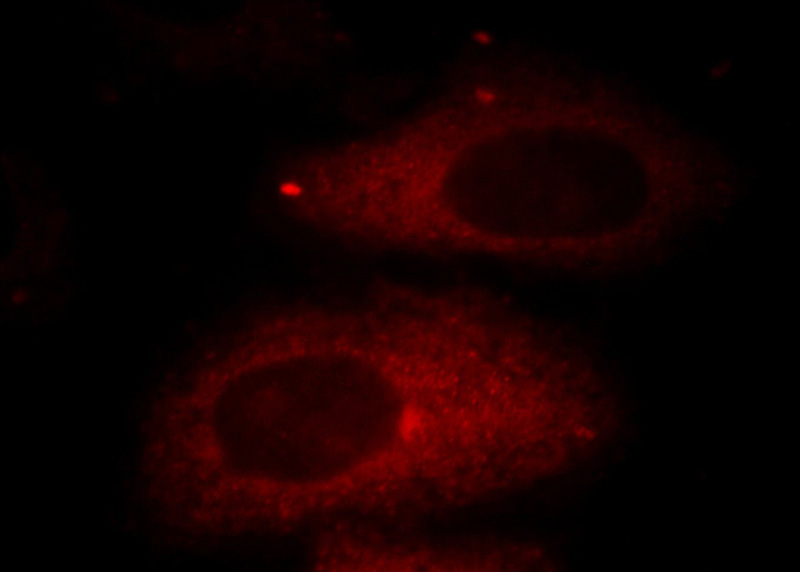
Immunofluorescent analysis of HepG2 cells, using HADHA antibody Catalog No:111333 at 1:25 dilution and Rhodamine-labeled goat anti-rabbit IgG (red).
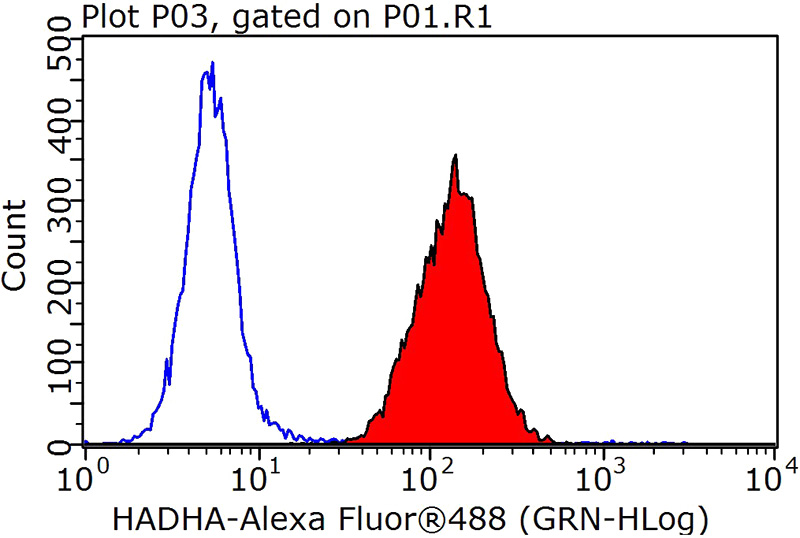
1X10^6 HepG2 cells were stained with 0.2ug HADHA antibody (Catalog No:111333, red) and control antibody (blue). Fixed with 90% MeOH blocked with 3% BSA (30 min). Alexa Fluor 488-congugated AffiniPure Goat Anti-Rabbit IgG(H+L) with dilution 1:1000.
-
Background
HADHA(Trifunctional enzyme subunit alpha, mitochondrial) is also named as HADH,78 kDa gastrin-binding protein.It belongs to the enoyl-CoA hydratase/isomerase family in the N-terminal section and the 3-hydroxyacyl-CoA dehydrogenase family in the central section.It harbors the 3-hydroxyacyl-CoA dehydrogenase and enoyl-CoA hydratase activities.Defects in HADHA are a cause of trifunctional protein deficiency (TFP deficiency) and long-chain 3-hydroxyl-CoA dehydrogenase deficiency (LCHAD deficiency) and maternal acute fatty liver of pregnancy (AFLP).
-
References
- Maher AC, Akhtar M, Tarnopolsky MA. Men supplemented with 17beta-estradiol have increased beta-oxidation capacity in skeletal muscle. Physiological genomics. 42(3):342-7. 2010.
- Maher AC, Akhtar M, Vockley J, Tarnopolsky MA. Women have higher protein content of beta-oxidation enzymes in skeletal muscle than men. PloS one. 5(8):e12025. 2010.
- Baandrup JD, Markvardsen LH, Peters CD. Pressure load: the main factor for altered gene expression in right ventricular hypertrophy in chronic hypoxic rats. PloS one. 6(1):e15859. 2011.
- Chocron ES, Sayre NL, Holstein D. The trifunctional protein mediates thyroid hormone receptor-dependent stimulation of mitochondria metabolism. Molecular endocrinology (Baltimore, Md.). 26(7):1117-28. 2012.
- Liao CC, Lin YL, Kuo CF. Effect of high-fat diet on hepatic proteomics of hamsters. Journal of agricultural and food chemistry. 63(6):1869-81. 2015.
- Richter-Dennerlein R, Korwitz A, Haag M. DNAJC19, a mitochondrial cochaperone associated with cardiomyopathy, forms a complex with prohibitins to regulate cardiolipin remodeling. Cell metabolism. 20(1):158-71. 2014.
Related Products / Services
Please note: All products are "FOR RESEARCH USE ONLY AND ARE NOT INTENDED FOR DIAGNOSTIC OR THERAPEUTIC USE"
